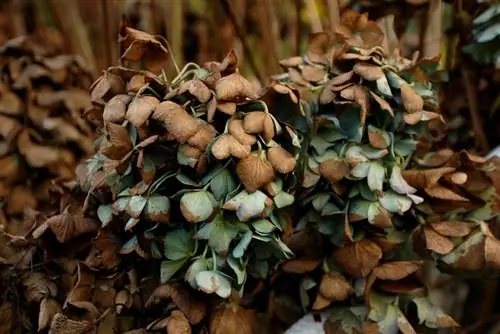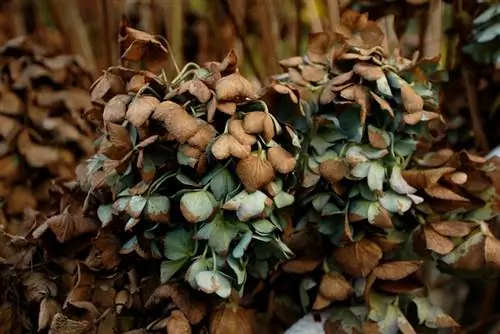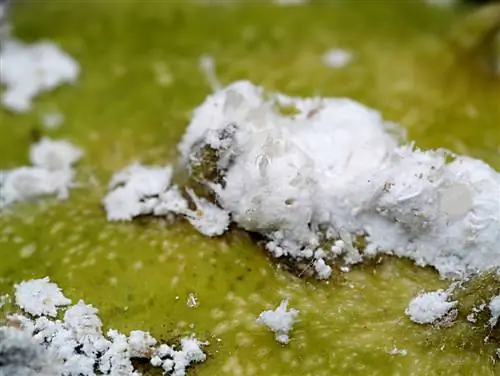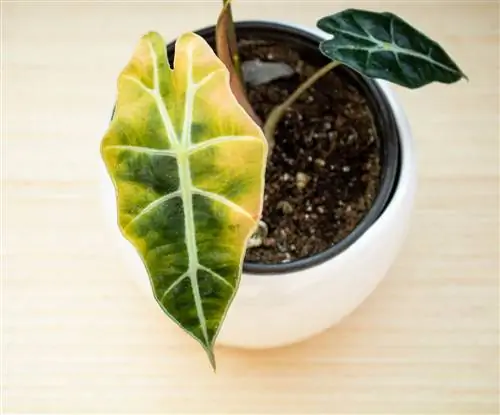- Author admin [email protected].
- Public 2023-12-16 16:46.
- Last modified 2025-01-23 11:20.
Even if your hydrangea is a picture of misery, drooping leaves and flowers, or losing its foliage, you shouldn't give up on the plant. As long as there is still some green left and the hydrangea is growing tentatively, a rescue attempt is definitely worth it.

What can you do to save a struggling hydrangea?
To save a struggling hydrangea, first identify the cause, such as pests, fungal diseases, waterlogging or drought. Treat pests and fungi with commercial products, remove infected roots and replant the hydrangea in fresh substrate. In dry conditions, water the plant adequately and prune if necessary.
Why does the hydrangea care?
If the hydrangea is not thriving, this can have various causes:
- Pests
- Fungal diseases
- Waterlogging
- drought
First examine the plant thoroughly for pests. If spider mites or lice have settled, they deprive the plant of vital nutrients and it withers away. Strong fungal infestation can also be the cause of poor growth.
Remedy
Both pests and fungi can be easily controlled using commercially available products.
Root rot due to waterlogging
If your hydrangea wilts even though it has been watered regularly, you probably meant too well. Although the hydrangea needs a lot of water, it reacts very sensitively to constant waterlogging of the root ball. If the hydrangea is too wet, this leads to a lack of oxygen and fungi settle in the root area, which destroy the roots. The delicate lifelines can no longer absorb water and the hydrangea withers.
Remedy
Carefully remove the hydrangea from its pot and examine the roots. He althy roots look white and feel crunchy. Roots affected by rot, on the other hand, are mushy and brown.
- Carefully remove the roots that are no longer viable so as not to damage the he althy root system.
- Place the hydrangea in a new planter with a large drainage hole and cover with a piece of pottery.
- First fill a drainage layer of expanded clay into the pot so that excess water is absorbed and drained away.
- Plant the hydrangea in fresh substrate, preferably rhododendron soil.
- In the future, only water when the top centimeters of soil feel dry and pour away excess water in the saucer after 15 minutes.
The hydrangea usually recovers quickly from this water stress and sprouts again after just one to two weeks.
The hydrangea has dried up
If the soil feels bone dry and the hydrangea leaves its leaves hanging limply, it is suffering from a lack of water. If this continues for a longer period of time, the leaves dry completely and fall off.
Remedy
- If the leaves are completely dry, the hydrangea must be cut back to the juicy wood.
- Place potted plants in a bucket filled with water and submerge until no more air bubbles rise.
- Get your fill of outdoor hydrangeas.
If it was necessary to shorten the hydrangea significantly, you will probably have to go without flowers this season. Nevertheless, the plants usually recover quickly, the foliage looks fresh and green again and the hydrangea sprouts again.
Tips & Tricks
Hytenseas outdoors are also sensitive to waterlogging. Therefore, a drainage layer made of coarse sand and gravel is recommended for clay substrates.






